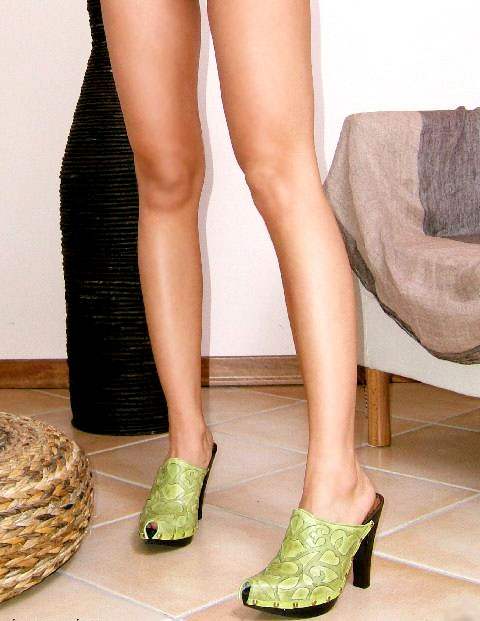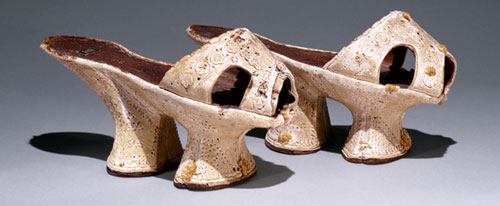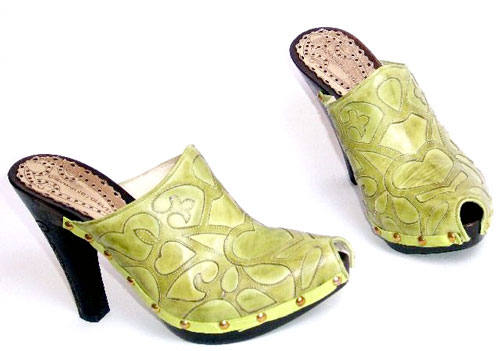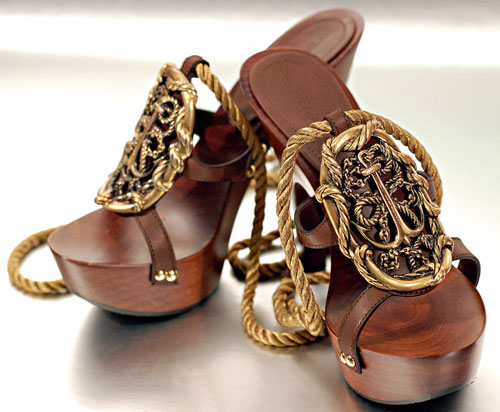
Fall in love this summer with a pair of green tooled leather clogs
with a hidden platform, by Gianmarco Lorenzi.
The high heel that helps elongate the female silhouette is not without its price, as ABC News reported in 2006. And while we may know this to be true with some experiencing knee and ankle injuries, the high heel as a fashion accessory is still loved by many, helping bring out the femme fatale in us.
The heel however, wasn’t all too sexy or “femme fatale” in its beginnings as demonstrated by this pair of 17th century Venetian Chopines by the Met Museum.

Ancient foot wear: 400 year old Venetian (Italian) Chopines, ca. 1600. Beige leather decorated with stamped and pierced designs and small pompoms of silk floss; L. 8 3/4 in. (22.2 cm). Purchase, Irene Lewisohn Bequest, 1973 (1973.114.4a,b) at the Met Museum.
Information about the Chopines from the Met Museum’s site:
Developed in the early sixteenth century, the chopine was designed to protect the foot from irregularly paved and wet or muddy streets, and also to symbolically enhance the wearer’s stature. Because of their height, chopines introduced an awkward instability to a woman’s gait. A Venetian woman wearing chopines would generally be accompanied by an attendant on whom she would balance. It was once thought that very high chopines—as much as twenty inches—were worn by courtesans to establish a highly visible public profile. However, sixteenth-century accounts suggest that height may have been associated with the wearer’s level of nobility and grandeur.
These days, an unexpected designated ‘working shoe’, the wooden clog (which has been around since the 1400s as depicted in Jan Van Eyck’s painting entitled Jan Arnolfini and his Wife), comes in platform and stiletto clad variations from various designers such as Gucci, Chanel, Chloé, Fendi, Mia, Michael Kors and Gianmarco Lorenzi.

Green wooden platform clogs by Gianmarco Lorenzi.
It was during the 1970s with platforms and wedges that clogs too, became trendy.
Easy to slip in and out of, clogs today are still used as ‘working shoes’ in Sweden, the Netherlands, northern France and low lying countries such as Belgium, Luxemburg and Denmark.
Even in Asia, wooden clogs are connotated with work. In Singapore for example, the cha kiak which is a pair of wooden clogs usually painted red in the base with a thick plastic front strap, are still sold today at the wet markets. They fit like a sandal and are used in the bathrooms or for when people are washing their courtyards.
While the heeled clog may be fashionable these days, the broad covering on the front makes it difficult to shake the connotated practical aspects of the footwear. As such, the strappy wooden heeled sandal offers a more graceful alternative and a less cumbersome look to the wooden heeled clog (even those designed with stiletto heels).

Wooden strappy platform heels with gold rope ankle ties, by Gianmarco Lorenzi.
Whether with platform, in wedges, cone shaped heel, with straps, on clogs etc., there’s something chic casual about the modern wooden heeled footwear that is smooth and sleek (unlike their clunkier 1970s cousins) that intrigues me and works as a staple in my wardrobe. I can see them with skinny jeans, cigarette pants, shorts, culottes, capris and even with pareo draped bikinis at the beach, complete with a straw beach hat, sunglasses and a straw bag.
In general the platformed wooden (high) heel is great for keeping feet out of rain and mud on the streets during the summer, by raising the feet from the ground. Their sexier designs today also makes easy complements to any woman’s wardrobe.
————————–oOo————————–
Readings on the fashionable high heel:
- Gamman, Larraine. 1993. “Self-Fashioning, Gender Display, and Sexy Girl Shoes: What’s at Stake—Female Fetishism or Narcissism?” in Footnotes on Shoes. Shari Benstock and Suzanne Ferriss, eds. New Brunswick, New Jersey: Rutgers University Press.
- Kunzle, David. 2004. Fashion and Fetishism: Corsets, Tight-Lacing, and Other Forms of Body-Sculpting. Thrupp, UK: Sutton Publishing Limited.
- Mitchell, Louise. 1997. Stepping Out: Three Centuries of Shoes. Sydney, Australia: Powerhouse Publishing.
- Murstein, Bernard I. 1974. Love, Sex, and Marriage through the Ages. New York, New York: Springer Publishing Company.
- Rexford, Nancy E. 2000. Women’s Shoes in America, 1795-1930. Kent, Ohio: Kent State University Press.
- Swann, June. 1984. Shoes. London, England: Butler & Tanner Ltd.
- Turim, Maureen.1993. “High Angles on Shoes.” The Shoe in Art, the Shoe as Art. In in Footnotes on Shoes. Shari Benstock and Suzanne Ferriss, eds. New Brunswick, New Jersey: Rutgers University Press.
- West, Janice. 1993. “The Shoe in Art, the Shoe as Art.” In in Footnotes on Shoes. Shari Benstock and Suzanne Ferriss, eds. New Brunswick, New Jersey: Rutgers University Press.
Wilson, Nigel Guy. 2005. Encyclopedia of Ancient Greece. New York, New York: Routledge. Accessed online at Google Books.
One thought on “The wooden heel: a summer staple”